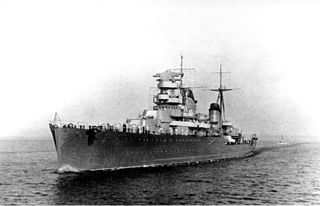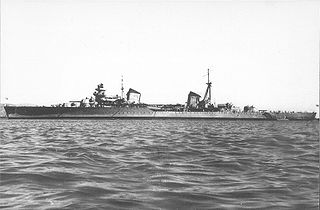 W
WThe Kirov-class cruisers were a class of six cruisers built in the late 1930s for the Soviet Navy. After the first two ships, armor protection was increased and subsequent ships are sometimes called the Maxim Gorky class. These were the first large ships built by the Soviets from the keel up after the Russian Civil War, and they were derived from the Italian cruiser Raimondo Montecuccoli, being designed with assistance from the Italian Ansaldo company. Two ships each were deployed in the Black and Baltic Seas during World War II, while the last pair was still under construction in the Russian Far East and saw no combat during the war. The first four ships bombarded Axis troops and facilities after the Germans invaded the Soviet Union in June 1941. All six ships survived the war and lingered in training and other secondary roles, with three being scrapped in the early 1960s and the other three a decade later.
 W
WKaganovich was a Project 26bis2 Kirov-class cruiser of the Soviet Navy that was built during World War II. She was built in Siberia from components shipped from European Russia. She saw no action during the war and served into the Cold War. She was renamed Lazar Kaganovich in 1945 to distinguish her from Lazar's disgraced brother Mikhail Kaganovich. Her post-war career was generally uneventful, although her superstructure was badly damaged by a Force 12 typhoon in 1957. She was renamed Petropavlovsk in 1957. Sources disagree on her fate; some say that she was converted into a floating barracks in 1960 and later sold for scrap while another says that she was simply sold for scrap in 1960.
 W
WKirov was a Project 26 Kirov-class cruiser of the Soviet Navy that served during the Winter War and World War II, and into the Cold War. She attempted to bombard Finnish coast defense guns during action in the Winter War, but was driven off by a number of near misses that damaged her. She led the Evacuation of Tallinn at the end of August 1941, before being blockaded in Leningrad where she could only provide gunfire support during the siege of Leningrad. She bombarded Finnish positions during the Vyborg–Petrozavodsk Offensive in mid-1944, but played no further part in the war. Kirov was reclassified as a training cruiser on 2 August 1961 and sold for scrap on 22 February 1974.
 W
WKaganovich was a Project 26bis2 Kirov-class cruiser of the Soviet Navy that was built during World War II. She was built in Siberia from components shipped from European Russia. She saw no action during the war and served into the Cold War. She was renamed Lazar Kaganovich in 1945 to distinguish her from Lazar's disgraced brother Mikhail Kaganovich. Her post-war career was generally uneventful, although her superstructure was badly damaged by a Force 12 typhoon in 1957. She was renamed Petropavlovsk in 1957. Sources disagree on her fate; some say that she was converted into a floating barracks in 1960 and later sold for scrap while another says that she was simply sold for scrap in 1960.
 W
WMaxim Gorky was a Project 26bis Kirov-class cruiser of the Soviet Navy that saw action during World War II and continued in service into the Cold War. The ship's bow was blown off by a mine in the Gulf of Riga during the opening stages of Operation Barbarossa, but she made it to Kronstadt for repairs. However, after being repaired, the ship was trapped in harbour for most of the war, by Axis minefields at Leningrad and Kronstadt. Despite being trapped, Maxim Gorky was active in two engagements: the ship provided gunfire in support for the defenders during the Siege of Leningrad, and she later bombarded Finnish positions during the Vyborg–Petrozavodsk Offensive in mid-1944. She saw no further action in World War II. A major modernization was begun in 1953, but the navy reconsidered the cost-effectiveness of the refit and work was cancelled in 1955. Maxim Gorky was sold for scrap in 1959.
 W
WMolotov was a Project 26bis Kirov-class cruiser of the Soviet Navy that served during World War II and into the Cold War. She supported Soviet troops during the Siege of Sevastopol, the Kerch-Feodosiya Operation and the amphibious landings at Novorossiysk at the end of January 1943.
 W
WKaganovich was a Project 26bis2 Kirov-class cruiser of the Soviet Navy that was built during World War II. She was built in Siberia from components shipped from European Russia. She saw no action during the war and served into the Cold War. She was renamed Lazar Kaganovich in 1945 to distinguish her from Lazar's disgraced brother Mikhail Kaganovich. Her post-war career was generally uneventful, although her superstructure was badly damaged by a Force 12 typhoon in 1957. She was renamed Petropavlovsk in 1957. Sources disagree on her fate; some say that she was converted into a floating barracks in 1960 and later sold for scrap while another says that she was simply sold for scrap in 1960.
 W
WMolotov was a Project 26bis Kirov-class cruiser of the Soviet Navy that served during World War II and into the Cold War. She supported Soviet troops during the Siege of Sevastopol, the Kerch-Feodosiya Operation and the amphibious landings at Novorossiysk at the end of January 1943.
 W
WVoroshilov was a Project 26 Kirov-class cruiser of the Soviet Navy that served during World War II and into the Cold War. She bombarded German troops during the siege of Odessa before being badly damaged in November 1941 by German bombers. Upon her return from repairs in March 1942 she supported Soviet troops during the siege of Sevastopol, the Kerch–Feodosiya operation and the amphibious landings at Novorossiysk at the end of January 1943. Her active participation in the war ended in October 1943 when three destroyers were lost to air attack and Joseph Stalin forbade missions using large ships without his permission. Postwar she was converted to a missile test ship before being sold for scrap in 1973.